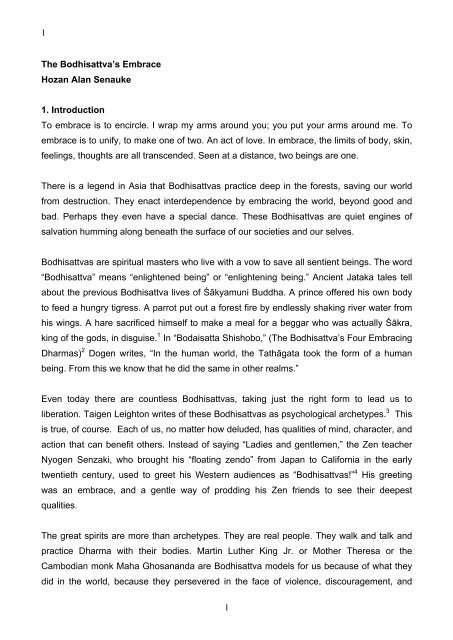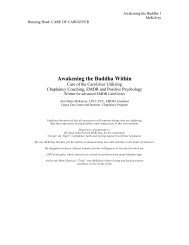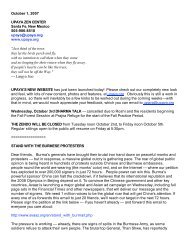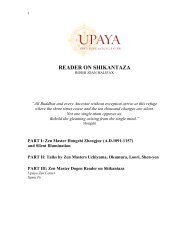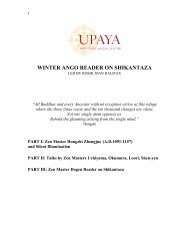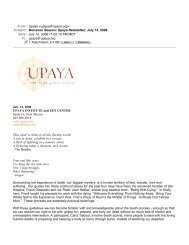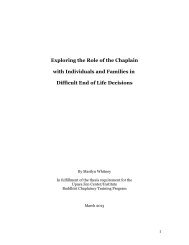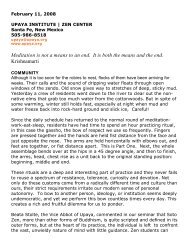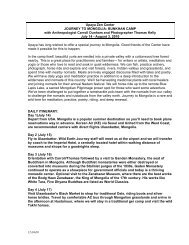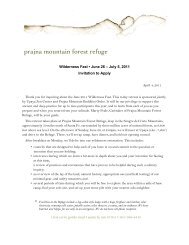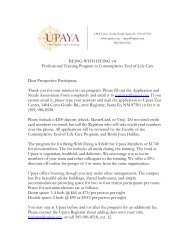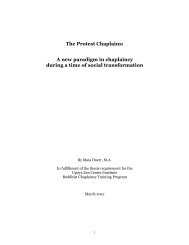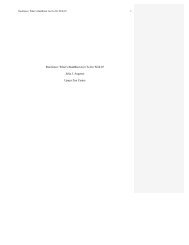The Bodhisattva's Embrace - Upaya Zen Center
The Bodhisattva's Embrace - Upaya Zen Center
The Bodhisattva's Embrace - Upaya Zen Center
You also want an ePaper? Increase the reach of your titles
YUMPU automatically turns print PDFs into web optimized ePapers that Google loves.
1<br />
<strong>The</strong> Bodhisattva’s <strong>Embrace</strong><br />
Hozan Alan Senauke<br />
1. Introduction<br />
To embrace is to encircle. I wrap my arms around you; you put your arms around me. To<br />
embrace is to unify, to make one of two. An act of love. In embrace, the limits of body, skin,<br />
feelings, thoughts are all transcended. Seen at a distance, two beings are one.<br />
<strong>The</strong>re is a legend in Asia that Bodhisattvas practice deep in the forests, saving our world<br />
from destruction. <strong>The</strong>y enact interdependence by embracing the world, beyond good and<br />
bad. Perhaps they even have a special dance. <strong>The</strong>se Bodhisattvas are quiet engines of<br />
salvation humming along beneath the surface of our societies and our selves.<br />
Bodhisattvas are spiritual masters who live with a vow to save all sentient beings. <strong>The</strong> word<br />
“Bodhisattva” means “enlightened being” or “enlightening being.” Ancient Jataka tales tell<br />
about the previous Bodhisattva lives of Śākyamuni Buddha. A prince offered his own body<br />
to feed a hungry tigress. A parrot put out a forest fire by endlessly shaking river water from<br />
his wings. A hare sacrificed himself to make a meal for a beggar who was actually Śākra,<br />
king of the gods, in disguise. 1 In “Bodaisatta Shishobo,” (<strong>The</strong> Bodhisattva’s Four Embracing<br />
Dharmas) 2 Dogen writes, “In the human world, the Tathāgata took the form of a human<br />
being. From this we know that he did the same in other realms.”<br />
Even today there are countless Bodhisattvas, taking just the right form to lead us to<br />
liberation. Taigen Leighton writes of these Bodhisattvas as psychological archetypes. 3 This<br />
is true, of course. Each of us, no matter how deluded, has qualities of mind, character, and<br />
action that can benefit others. Instead of saying “Ladies and gentlemen,” the <strong>Zen</strong> teacher<br />
Nyogen Senzaki, who brought his “floating zendo” from Japan to California in the early<br />
twentieth century, used to greet his Western audiences as “Bodhisattvas!” 4 His greeting<br />
was an embrace, and a gentle way of prodding his <strong>Zen</strong> friends to see their deepest<br />
qualities.<br />
<strong>The</strong> great spirits are more than archetypes. <strong>The</strong>y are real people. <strong>The</strong>y walk and talk and<br />
practice Dharma with their bodies. Martin Luther King Jr. or Mother <strong>The</strong>resa or the<br />
Cambodian monk Maha Ghosananda are Bodhisattva models for us because of what they<br />
did in the world, because they persevered in the face of violence, discouragement, and<br />
1
2<br />
countless dark nights of the soul. When we meet such beings, whether or not we<br />
understand or agree with them, we feel embraced, and instinctively we respond.<br />
A Bodhisattva’s vow to save all sentient beings means that she chooses to live within the<br />
world of karma, or cause and effect. A Bodhisattva embraces even failure with a willingness<br />
to begin again and again.<br />
Buddhism is a universal religion. Its core truth is that each of us is continuously expressing<br />
Buddha-nature. This very mind and body are Buddha. You and I are Buddha. No one is<br />
outside the circle of awakening. We are Buddhas manifesting as Buddhas. And, although<br />
every being is Buddha, we are still in need of cultivation. As Shunryu Suzuki Roshi said,<br />
"Each of you is perfect the way you are…and you can use a little improvement." 5 This<br />
improvement is cultivation. It consists of practices that each of us must take on, not for selfimprovement,<br />
but for the sake of peace. <strong>The</strong> Vimalakīrti Sutra, one of Mahayana<br />
Buddhism’s key texts, describes the Bodhisattva’s social mandate for peacemaking both in<br />
terms of manifesting and cultivating.<br />
During the short eons of swords,<br />
<strong>The</strong>y meditate on love,<br />
Introducing to nonviolence<br />
Hundreds of millions of living beings.<br />
In the middle of great battles<br />
<strong>The</strong>y remain impartial to both sides;<br />
For bodhisattvas of great strength<br />
Delight in reconciliation of conflict.<br />
In order to help the living beings,<br />
<strong>The</strong>y voluntarily descend into<br />
<strong>The</strong> hells which are attached<br />
To all the inconceivable Buddha-fields 6<br />
In “Bodaisatta Shishobo” Dogen <strong>Zen</strong>ji offers four (or otherwise counted, sixteen) specific<br />
tools and practices for cultivating and manifesting our life as Bodhisattvas in the midst of<br />
society beyond the temple’s walls. And when we use the proper tool to help others --<br />
2
3<br />
following Avalokiteśvara, who in each of her thousand hands wields a tool for liberating<br />
beings -- we also free ourselves.<br />
2. Dogen <strong>Zen</strong>ji and the Shobogenzo<br />
Dogen <strong>Zen</strong>ji brought the traditions of Soto <strong>Zen</strong> from China in the early part of the thirteenth<br />
century. He has become a towering figure in the history of Japanese Buddhism. Dogen’s<br />
birth is shrouded in mystery, but we do know that in the year 1200 he was born into an<br />
aristocratic Kyoto family. His parents died when he was still a child. It is said that, at the age<br />
of eight, smoke rising from incense at his mother’s funeral impressed upon him the sad and<br />
inescapable reality of impermanence. At thirteen Dogen became a monk at Mount Hiei, the<br />
great monastic center of Tendai Buddhism in Japan. Practicing meditation and devotion day<br />
after day, he sought an answer to a question that fueled his great doubt.<br />
Both exoteric and esoteric teachings explain that a person in essence has true<br />
Dharma-nature and is originally a body of “Buddha-nature.” If so, why do all<br />
Buddhas in the past, present, and future arouse the wish for and seek<br />
enlightenment 7<br />
More succinctly, if we are already Buddhas—if we are already saved and inherently<br />
awake—why do we need to practice Actually this is a central issue in every faith tradition.<br />
Dogen’s Tendai teachers suggested that an answer might be more readily found in the <strong>Zen</strong><br />
school, which didn’t flinch at ambiguity. Dogen took up studies with Master Eisai, a monk<br />
who had studied Rinzai-style <strong>Zen</strong> in China, bringing it to Japan for the first time in 1191.<br />
Eisai died in 1215, and Dogen continued his studies with Eisai’s successor Myozen, who<br />
became Dogen’s close friend and mentor.<br />
Together Myozen and Dogen made the perilous journey to China in 1223, visiting the <strong>Zen</strong><br />
monasteries of Southern China. Myozen settled down at one of these training centers, but<br />
Dogen continued to look for his true teacher. In 1225 Myozen passed away. In the same<br />
year Dogen found his teacher Rujing at Mount Tiantong. Rujing and Dogen recognized<br />
each other immediately, and Rujing gave this young disciple permission to come to his<br />
room with questions at any time of day or night.<br />
One evening during the summer training period, Rujing shouted at a sleepy monk, “When<br />
you study under a master, you must drop body and mind. What is the use of single-minded<br />
3
4<br />
intense sleeping” Dogen, who had been sitting next to the chastened monk, suddenly<br />
experienced a great awakening. All his previous doubts were resolved. He went to Rujing’s<br />
quarters and offered incense. Rujing asked, “What is the incense burning for” Dogen<br />
replied, “My body and mind have dropped away. That is why I come.” 8 Rujing verified this<br />
experience and formally transmitted the Dharma to Dogen.<br />
Dogen returned to Japan as a <strong>Zen</strong> master. He later wrote:<br />
Not having visited too many <strong>Zen</strong> monasteries, but having only studied under<br />
my Late Master Rujing, I plainly realized that the eyes are horizontal and the<br />
nose vertical. Without being deceived by anyone, I came home emptyhanded.<br />
9<br />
But he did come home with clear ideas about Buddhism rooted in zazen, the meditation<br />
practice he described as “practice-enlightenment.” Against the notion of meditating in order<br />
to attain realization, Dogen proposed that the practice of zazen is itself the expression of<br />
realization. He stood conventional notions of <strong>Zen</strong> on their head. Yet he was clear one still<br />
had to take up a rigorous practice of self-study in order to see the truth that is always right<br />
before our eyes.<br />
So Dogen set up temples and monasteries, with rules based on his Chinese experience.<br />
And he began to write about <strong>Zen</strong> practice from every imaginable angle. Shobogenzo<br />
(Treasury of the True Dharma Eye), his masterwork, was begun in 1233 and its writing<br />
continued for fifteen years. As a religious and philosophical work, it is perhaps unmatched<br />
in any culture for the depth and challenge of its ideas, and for the difficult beauty of Dogen’s<br />
language. Dogen was one of those rare writers who used words themselves to go beneath<br />
and beyond the conceptual trap of words. We can see this in “Bodaisatta Shishobo” (<strong>The</strong><br />
Bodhisattva’s Four Embracing Dharmas), which became Chapter Twenty-Eight of the<br />
Shobogenzo. <strong>The</strong> “Bodaisatta Shishobo” was written in the summer of 1243, shortly before<br />
Dogen’s community abruptly left Kyoto for the remote mountain forests of Echizen.<br />
Historians are not certain why this move was so sudden, but there is a strong suggestion of<br />
sectarian conflict and possibly violence between Dogen’s community and other more<br />
established sects. Perhaps it was the urgency of conflict that turned Dogen’s thoughts in<br />
the direction of these Bodhisattva practices.<br />
4
5<br />
3. <strong>The</strong> Bodhisattva’s Four Embracing Dharmas<br />
<strong>The</strong> Four Embracing Dharmas are Giving, or dāna; Loving-Speech; Beneficial-Action; and<br />
what Dogen calls Identity-Action. Each dharma or practice is a method for connecting -- a<br />
way to manifest the truth that we are not separate from each other. Because we are truly<br />
not separate from others, these four Dharmas allow Bodhisattvas and sentient beings to<br />
become free from the poisons of greed, hatred, and delusion. In embrace there is no<br />
distinction between self and other, between a Bodhisattva and an ordinary being.<br />
<strong>The</strong>se were already ancient practices in Dogen’s time. <strong>The</strong>y are found as the four sangaha<br />
vatthu, the Foundations for Social Unity in early Pali texts like the Sangaha Sutta: dāna,<br />
generosity; piyavaca, kindly speech; atthacariya, helpful action; and samanattata,<br />
cooperation or impartiality. In the Mahayana tradition, they appear in the Lotus Sutra,<br />
Māhaprajnāpāramitā Sutra, the Vimalakīrti Sutra and many other well-known teachings.<br />
A. Giving<br />
<strong>The</strong> Bodhisattva’s essential practice of peace is giving. Giving one's attention, friendship,<br />
and material aid. Giving spiritual teachings, community, and organization. Giving<br />
fearlessness. Giving is the first pāramitā or perfection, and it includes all other perfections.<br />
Dogen begins “Bodaisatta Shishobo” by explaining that<br />
Giving or Offering means not being greedy. Not to be greedy means not to<br />
covet. Not to covet commonly means not to flatter. Even if we rule the four<br />
continents, in order to offer teachings of the true Way we must simply and<br />
unfailingly not be greedy. It is like offering treasures we are about to discard to<br />
those we do not know. We give flowers blooming on the distant mountains to<br />
the Tathāgata, and offer treasures accumulated in past lives to living beings.<br />
Whether our gifts are Dharma or material objects, each gift is truly endowed<br />
with the virtue of offering, or dāna.<br />
Giving begins with oneself. I give myself to practice, and practice offers itself to me. In my<br />
search for peace, I find there is always the pervasive smell of war. <strong>The</strong> taste of tears,<br />
corrosive doubt, and decay fall within the circle of my own body and mind. A war goes on<br />
here, right where I hide behind a mask of self-attachment. Hiding out in a shelter of<br />
privilege, I cut myself off from others. True giving is receiving the gift of zazen mind and<br />
passing it to others in words and deeds. It means not hiding. It also means giving<br />
5
6<br />
fearlessness by showing others that I am willing to face my own failure and despair as a<br />
natural part of being completely alive.<br />
We offer gifts and guidance in many forms. At the heart of these teachings is the<br />
understanding that peace is making connection. On a basic, level material goods are given.<br />
On a higher level, teaching is shared. And on the highest level, there is just connection, the<br />
endless society of being, the vast assembly of Bodhisattvas. In his wonderful book <strong>The</strong> Gift,<br />
Lewis Hyde describes dinner in a cheap restaurant in the South of France.<br />
<strong>The</strong> patrons sit at a long communal table, and each finds before his plate a<br />
modest bottle of wine. Before the meal begins, a man will pour his wine not<br />
into his own glass but into his neighbor's. And his neighbor will return the<br />
gesture, filling the first man's empty glass. In an economic sense nothing has<br />
happened. No one has any more wine than he did to begin with. But society<br />
has appeared where there was none before. 10<br />
<strong>The</strong> gift itself is only a gift so long as it remains in circulation. A monk or nun carries an<br />
empty bowl from house to house. <strong>The</strong> bowl is emptiness, yet in this material world, food is<br />
offered so that one may live. Emptiness and form embrace and dance. Having eaten, the<br />
monk or nun transforms food into action and practice, which is again offered up to nourish<br />
all beings. <strong>The</strong> dance of peace continues. Again from Lewis Hyde:<br />
I would like to speak of gratitude as a labor undertaken by the soul to effect<br />
the transformation after a gift has been received. Between the time a gift<br />
comes to us and the time we pass it along, we suffer gratitude. Moreover, with<br />
gifts that are agents of change, it is only when the gift has worked in us, only<br />
when we come up to its level, as it were, that we can give it away again.<br />
Passing the gift along is the act of gratitude that finishes the labor. 11<br />
Giving is not an abstract thing. It takes place in the world itself. Dogen writes:<br />
To provide a boat or build a bridge is offering as the practice of dānapāramitā.<br />
When we carefully learn the meaning of giving, both receiving our<br />
body and giving up our body are offering. Earning our livelihood and<br />
managing our business are, from the outset, nothing other than giving.<br />
6
7<br />
Trusting flowers to the wind, and trusting birds to the season may also be the<br />
meritorious action of dāna.<br />
In all our worldly actions, we should consider what others need and what we can give them<br />
without nourishing our own self-centeredness. This is always a difficult practice. Dogen<br />
says bluntly, “<strong>The</strong> mind of a sentient being is difficult to change.” Amen to that! This is true<br />
for others, and doubly for ourselves.<br />
B. Loving-Speech<br />
Loving or kind speech means telling the truth in a way that leads to right action. <strong>The</strong><br />
Buddha suggested that before speaking we consider whether our words are true, useful,<br />
and timely. Will they actually be heard And will they have a good effect<br />
Words are like arrows, or heat-seeking missiles. Once spoken they head straight for their<br />
target and cannot be called back. <strong>The</strong>y have a capacity to wound or to heal, so their use<br />
calls for great care. Dogen writes:<br />
Loving-Speech mean, first of all, to arouse compassionate mind when<br />
meeting with living beings, and to offer caring and loving words. In general,<br />
we should not use any violent or harmful words.<br />
Two books by the late <strong>Zen</strong> teacher Dainin Katagiri were edited from his talks. <strong>The</strong> first book<br />
was titled Returning to Silence. This is the silence of zazen, the vast and still ground of<br />
being which is spoken about in the mystic teachings of every tradition. His second book<br />
was You Have to Say Something. I don’t know whether this pairing was the editors’<br />
conscious intention, but it represents something basic about a life of Buddhist practice.<br />
After his enlightenment under the Bodhi tree, Śākyamuni Buddha was intending to remain<br />
in blissful silence. But the gods Brahma and Indra begged him to teach, to say something,<br />
And so he did. He taught us how to be intimate with the silence in all things. Silence informs<br />
all we are and all we do. And for the sake of all beings, we have to come forth from that<br />
silence into the world of words and actions.<br />
“To speak with a mind that ‘compassionately cares for living beings as if they were our own<br />
babies’ is Loving-Speech.” We speak in a kindly voice to our children. But in emergency a<br />
parent will shout a warning or a corrective. It often takes a raised voice to get someone’s<br />
attention. This is also Loving-Speech<br />
7
8<br />
Dogen writes, “We should study how Loving-Speech has power to transform the world.”<br />
Our everyday language is often debased. Advertisements bombard us with lies and false<br />
claims. Politicians and leaders carefully select words, but their care is about self-protection<br />
and/or national chauvinism. When was the last time we have a leader apologize for an<br />
injustice or violence imposed on their own citizens or another nation But words can convey<br />
honesty, repentance, and generosity. <strong>The</strong>n they move the world towards peace. Narrowly<br />
crafted policy pronouncements are not Loving-Speech. Yet Loving-Speech is actually all<br />
around us. It is spoken by mothers and children, poets and writers. It actually goes beyond<br />
words to include music, dance, and silent prayer. Such speech is the source of our truest,<br />
most enduring power.<br />
C. Beneficial-Action<br />
Beneficial-Action is the work of harmonizing ourselves and the whole world. <strong>The</strong><br />
Bodhisattva Avalokiteśvara has a thousand arms. Each hand wields a tool of liberation and<br />
each palm has its own discerning eye. Beneficial-Action means looking, listening, and<br />
helping without thinking about what we will get out of it. Dogen <strong>Zen</strong>ji explains:<br />
Ignorant people may think that if we benefit others too much, our own benefit<br />
will be excluded. This is not the case. Beneficial-Action is the whole of<br />
Dharma; it benefits both self and other widely.<br />
Like Loving-Speech, Beneficial-Action is clearly an expression of Giving. It is not charity,<br />
though. In the West, charity is often motivated by two factors, the first a sense of moral or<br />
social obligation, noblesse oblige, and the second is the benefit, real or imagined, that<br />
accrues to oneself in return for an act of charity. Beneficial-Action is done simply for the<br />
sake of the action itself, without concern for any outcome or benefit.<br />
In the Gospel of Matthew, Jesus tells his followers, “Love your enemies and pray for those<br />
who persecute you.” Preaching on this verse, Martin Luther King Jr. said that in seeking to<br />
love one’s enemy, one must<br />
discover the element of good in one’s enemy. And every time you begin to hate<br />
that person, realize that there is some good there and look at those good points<br />
which will over-balance the bad point…<strong>The</strong>re is a recalcitrant South of our soul<br />
revolting against the North of our soul…<strong>The</strong>re is something within each of us that<br />
8
9<br />
causes us to cry out with Goethe: “<strong>The</strong>re is enough stuff in me to make both a<br />
gentleman and a rogue.” 12<br />
Dogen <strong>Zen</strong>ji writes in the same spirit, but he extends Beneficial-Action to the whole earth<br />
and its elements.<br />
We should equally benefit friends and foes alike; we should benefit self and<br />
others alike.… If we attain such a mind we can perform Beneficial-Action even for<br />
grass, trees, wind, and water.<br />
Our meditation practice or zazen is the essence of Beneficial-Action. Zazen is selfless<br />
activity beyond the usual meaning of “good” and “bad.” It is a rare kind of body-mind<br />
practice that transcends karma. As we harmonize our individual body and mind, zazen<br />
mysteriously harmonizes the whole world. Maybe there is no mystery. As each of us is at<br />
peace, those around us naturally resonate with the energy of peace. Peace ripples out in<br />
widening circles.<br />
D. Identity-Action<br />
A great Bodhisattva lives in this suffering world with a vow to save all beings before saving<br />
herself. She or he may appear as a street person, as a soldier, as a bank teller, a<br />
mechanic, a prostitute, short-order cook, musician, preacher, mail carrier, or monk. <strong>The</strong><br />
practice of Identity-Action entails the continuous reinvention of self. This is what Buddhist<br />
call “skillful means” or upāya, meeting each suffering being exactly as he or she needs to<br />
be met. Such a reinvention is neither pretense nor act. Using Identity-Action we reinvent<br />
ourselves according to our inborn Bodhisattva instinct.<br />
This, I think is the deepest of the Four Embracing Dharmas. While the Old Testament of<br />
the Bible teaches Justice and the New Testament teaches Love, Buddhism teaches about<br />
Identity, the oneness of all being, and the difference of each interwoven existence.<br />
Samanattata, as it is used in the early Pali text quoted above, may be translated as<br />
cooperation, impartiality, or consistency. Dogen reaches further:<br />
Identity-Action means not to be different — neither different from self nor from<br />
others. For example, it is how, in the human world, the Tathāgata identifies<br />
himself with human beings. Because he identifies himself in the human world, we<br />
9
10<br />
know that he must be the same in other worlds. When we realize Identity-Action,<br />
self and others are one suchness.<br />
Dogen’s presentation on Identity-Action closes with a meditation on relations between a<br />
nation’s people and their ruler.<br />
Because mountains do not refuse to be mountains, they can be mountains and<br />
reach great heights. Because wise rulers do not weary of their people they attract<br />
many people. “Many people” means a nation. “A wise ruler” may mean an<br />
emperor. Emperors do not weary of their people. This does not mean that they<br />
fail to offer rewards and punishments, but that they never tire of their<br />
people…Because wise rulers are clear, they do not weary of their people.<br />
Although people always desire to form a nation and to find a wise ruler, few of<br />
them fully understand the reason why a wise ruler is wise. <strong>The</strong>refore, they are<br />
simply glad to be embraced by the wise ruler. <strong>The</strong>y don’t realize that they<br />
themselves are embracing a wise ruler. Thus the principle of Identity-Action<br />
exists both in the wise ruler and ignorant people.<br />
Like much of Dogen’s writing, this metaphor works on several levels at once. On one level,<br />
each of us, citizens in a national state, feels related our president, prime minister or<br />
king…whether we like it or not. On another level, our own body is kind of a nation. Mind is<br />
ruler, but for its own proper function it depends on the function of muscles, bones, and<br />
organs. When all elements are working together our body is healthy, even though we<br />
ourselves are never fully aware of how this functioning occurs. In this way, we ourselves<br />
are “the wise ruler and ignorant people.”<br />
Dogen’s metaphor of governance is as much rotted in Confucian values as in<br />
Buddhadharma. Yet it accords with his vision of Buddhism, offering both a critique and a<br />
directive about how to understand society. Identity-Action is simply an expression of what<br />
the ancestors called Dependent Origination. Because there is this, there is that. Because<br />
this arises, that arises. Together they make up an inseparable whole that we conventionally<br />
call a nation. But each nation and each person is part of an endless tapestry of existence<br />
made of whole cloth. Katagiri Roshi said: “Differentiation must be formed not in<br />
differentiation, but in equality. <strong>The</strong>n, differentiation and equality are working in Identity-<br />
Action.”<br />
10
11<br />
Like Confucius, Dogen was an idealist. But Dogen was unafraid to roll up the long sleeves<br />
of his robe. Confucius wrote, “When the perfect order prevails, the world is like a home<br />
shared by all.” Soon after writing Shishobo, Dogen set out for the forests of Echizen<br />
province to build a great monastery, Eiheiji, his “Temple of Eternal Peace.” Seven hundred<br />
years later, Eiheiji monks still blend with each other “like milk and water.” <strong>The</strong> great trees<br />
and the long monastic halls embrace and dance together as Dogen would have wished.<br />
<strong>The</strong> Bodhisattvas rejoice.<br />
4. “I Know Just How You Feel”<br />
In June of 1964 three civil rights workers — James Chaney, Andrew Goodman, and Mickey<br />
Schwerener — were murdered by the Ku Klux Klan in Neshoba County, Mississippi. Klan<br />
member Horace Burnette later gave a confession to the FBI. Burnette described the events<br />
of that terrible night. By the side of a country road Alton Wayne Roberts pulled Mickey<br />
Schwerner out of the rights workers’ car. He put a gun to Schwerner’s head, saying, “Are<br />
you that nigger lover” Schwerner replied, “Sir, I know just how you feel.” Schwerner and<br />
his co-workers were shot and buried beneath an earthen dam. 13<br />
A Bodhisattva practices without regard for success or failure. Civil rights workers in<br />
Mississippi were thoroughly trained in the practice of nonviolence, which is in fact the<br />
Bodhisattva’s Four Embracing Dharmas. Because he understood Identity-Action, Mickey<br />
Schwerner could say, “Sir, I know just how you feel.” What did he mean Did he<br />
understand Wayne Roberts’ fear or his hatred Were they, in fact Mickey Schwerner’s own<br />
feelings We will never know. Schwerner’s compassionate response did not save his life,<br />
but the karma of his words is still unfolding. Because of his courage, a man confessed to<br />
these murders. We are still studying his words and actions, vowing to make them our own.<br />
At the end of Bodaisatta Shishobo, Dogen writes, “Because each of these Four Embracing<br />
Dharmas includes all the Four Embracing Dharmas, there are Sixteen Embracing<br />
Dharmas.” This is another way of expressing the interpenetrating nature of things. None of<br />
these practices exists apart from the others. Giving implies Loving-Speech, Beneficial-<br />
Action, and Identity-Action. Identity-Action is our true nature, bringing forth all the other<br />
Dharmas. And so on. Practicing one Dharma, we practice all four. Practicing all four<br />
Dharmas, we embrace all being, dancing with our head among the clouds of heaven and<br />
our feet stepping along the ocean’s muddy bottom.<br />
11
12<br />
Biographical Information<br />
Hozan Alan Senauke is a Soto <strong>Zen</strong> ordained by Sojun Mel Weitsman Roshi in 1989. Alan<br />
serves as tanto or head of practice at Berkeley <strong>Zen</strong> <strong>Center</strong> in California, where he lives with<br />
his wife, Laurie, and their two children, Silvie and Alexander. As the Buddhist Peace<br />
Fellowship’s Senior Advisor, he continues to work as a social activist around issues of<br />
peace, human rights, structural violence, and the development of a Socially Engaged<br />
Buddhism. In another realm, Alan has been a student and performer of American traditional<br />
music for more than forty years.<br />
Hozan Alan Senauke<br />
1933 Russell Street<br />
Berkeley, CA 94703<br />
510-845-2215<br />
alans@kushiki.org<br />
1 Jataka 315: “Sasa-Jatata,” in <strong>The</strong> Jataka or Stories of the Buddha’s Former Births, Vol. III, edited by E.B.<br />
Cowell, (London: Pali Text Society, 1957).<br />
2 “Shobogenzo Shishobo” (<strong>The</strong> Bodhisattva’s Four Embracing Dharmas), fascicle 28 in Dogen <strong>Zen</strong>ji’s 60-<br />
fascicle version of the Shobogenzo, (Treasury of the True Dharma Eye).<br />
3 Faces of Compassion: Classic Bodhisattva Archetypes and <strong>The</strong>ir Modern Expression, by Taigen Dan<br />
Leighton, (Somerville, Ma., Wisdom Publications 2005).<br />
4 Taking the Path of <strong>Zen</strong>, by Robert Aitken, (San Francisco, North Point, 1982), p. 61.<br />
5 To Shine One Corner of the World: Moments with Shunryu Suzuki, by Shunryu Suzuki, edited by David<br />
Chadwick, (New York, Broadway, 2001), p.3.<br />
6 <strong>The</strong> Holy Teaching of Vimalakirti, translated by Robert Thurman, (University Park, Pennsylvania State<br />
University Press, 1988), pp.67-72.<br />
7 Moon in a Dew Drop: Writings of <strong>Zen</strong> Master Dogen, edited by Kazuaki Tanahashi, (San Francisco, North<br />
Point, 1985), p. 4.<br />
8 Dogen’s Formative Years in China, by Takashi James Kodera, (Boulder, Prajna Press, 1980), pp.<br />
60-61.<br />
9 Dogen’s Formative Years…, p. 77.<br />
12
13<br />
10 <strong>The</strong> Gift: Imagination and the Erotic Life of Property, by Lewis Hyde (New York, Vintage, 1979), pp. 56-57.<br />
11 <strong>The</strong> Gift, p. 47.<br />
12 from “Loving Your Enemies,” by Rev. Martin Luther King, Jr., Dexter Avenue Baptist Church, Montgomery,<br />
Al., 17 November 1957.<br />
(www.stanford.edu/group/King/publications/sermons/571117.002_Loving_Your_Enemies.html).<br />
13 Pillar of Fire: America in the King Years 1963-65, by Taylor Branch (New York, Simon & Schuster, 1998),<br />
pp.508-509.<br />
13


